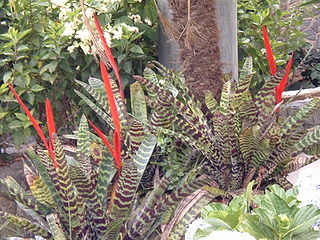
Gynerium is a monotypic genus of Neotropical plants in the grass family, native to Mexico and Colombia, Central America, South America, and the West Indies. It is classified in its own tribe Gynerieae.

Aechmea tillandsioides is a bromeliad widespread across southern Mexico, Central America, and northern South America. It is widely cultivated in other regions as an ornamental plant. This plant is cited in Flora Brasiliensis by Carl Friedrich Philipp von Martius.

Hypoxis decumbens is a species of plant in the Hypoxidaceae, considered by some authors to be included within the Liliaceae or Amaryllidaceae. The species is widespread across South America, Central America, Mexico, and the West Indies.

Vriesea splendens, or flaming sword, is a species of flowering plant in the family Bromeliaceae, subfamily Tillandsioideae. Native to Trinidad, eastern Venezuela and the Guianas these plants were introduced to Europe in 1840. This species of Vriesea features smooth-margined foliage with brown bands growing in a rosette, usually producing a bright red inflorescence in a flattened spike. It is a recipient of the Royal Horticultural Society's Award of Garden Merit.

Tonina fluviatilis is a plant species in the Eriocaulaceae. It is the sole species in the monotypic genus Tonina, native to southern Mexico, Central America, northern South America, Cuba and Trinidad.

Rhodospatha is a genus of plant in family Araceae. It is native to South America, Central America, and southern Mexico.
Thoracocarpus is a genus of plants first described as a genus in 1958. It contains only one known species, Thoracocarpus bissectus a hemiepiphytic vine. It is native to Costa Rica, Panama, Cuba, Trinidad and Tobago, and South America.

Aganisia pulchella is a species of orchid native to Trinidad, French Guiana, Suriname, Guyana, Venezuela, Brazil. It is the type species of the genus Aganisia.
Streptostachys is a genus of South American plants in the grass family.

Homolepis is a genus of Neotropical plants in the grass family. They are native to Mexico, Central and South America, and the West Indies.

Aechmea angustifolia is a plant species in the genus Aechmea. This species is native to Central America and northern South America.

Tillandsia balbisiana, common name northern needleleaf, is a species of bromeliad in the genus Tillandsia. This species in native to Mexico, Central America, Colombia, Venezuela, the West Indies, and Florida.

Tillandsia bulbosa, the bulbous airplant, is a species of flowering plant in the genus Tillandsia. It is widespread across Central America, the West Indies, southern Mexico, and northern and eastern South America.

Catopsis floribunda is a species in the genus Catopsis. This species is native to the West Indies, Venezuela, Honduras, Oaxaca, and Florida.

Sarcoglottis is a genus of flowering plants from the orchid family, Orchidaceae. It is widespread across much of Latin America from Mexico to Argentina, with one species extending northward into Trinidad and the Windward Islands.

Burmannia capitata is a plant species widespread across the West Indies and much of Latin America. It grows in wet areas at elevations less than 100 m. It has been reported from Argentina, Belize, Bolivia, Brazil, Cuba, the Dominican Republic, Haiti, Jamaica, Puerto Rico, Trinidad & Tobago, Colombia, Costa Rica, French Guiana, Guyana, Honduras, southern Mexico, Nicaragua, Panamá, Paraguay, Suriname, Venezuela, and the United States

Brachystele guayanensis is a species of orchid. It is native to southern Mexico, Central America, Trinidad & Tobago, and northern South America.
Bulbophyllum pinelianum, the rat-tail orchid, is a species of orchid in the genus Bulbophyllum. It is widespread across southern Mexico, the West Indies, Central America and northern South America. It is also reported from Florida but apparently now extinct in that state.

Dictyostega is a genus of flowering plants in the Burmanniaceae, first described as a genus in 1840. It contains only one known species, Dictyostega orobanchoides, native to southern Mexico, Central America, Trinidad, and South America ).

Dimerocostus is a group of plants in the Costaceae described as a genus in 1891. It is native to Central and South America.

















